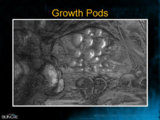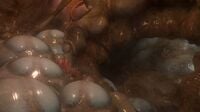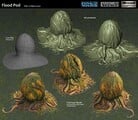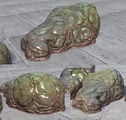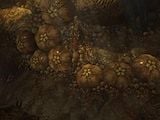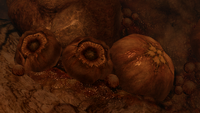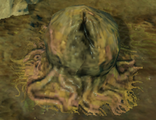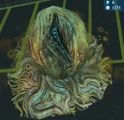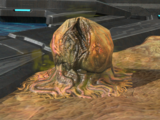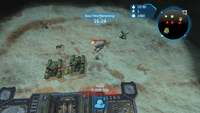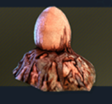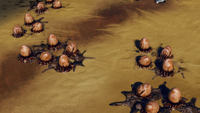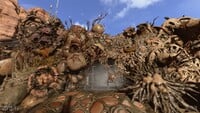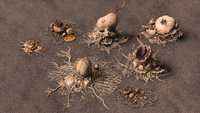Flood blister: Difference between revisions
From Halopedia, the Halo wiki
mNo edit summary |
(Minor tweaks) Tag: Mobile edit |
||
| (36 intermediate revisions by 16 users not shown) | |||
| Line 1: | Line 1: | ||
{{ | {{Status|Canon}} | ||
{{Flood | {{Flood infobox | ||
|name= | |name=Flood blister | ||
|image=[[ | |image=[[File:Flood biomass.jpg|300px]] | ||
|distinctions=Large, spherical pods that contain [[Flood]] [[infection forms]] and incubate [[Flood spore|spores]]{{Ref/Book|Id=enc22|Enc22|Page=407}} | |||
|distinctions= Large, spherical pods | |height=Varies{{Ref/Reuse|enc22}} | ||
| | |mass=Varies{{Ref/Reuse|enc22}} | ||
|attacks= | |attacks= | ||
|notable= | |notable= | ||
}} | }} | ||
'''Flood | {{Quote|So many ways this sickness spreads itself! Keep your distance from those blisters, they seem to know when we are close!|[[Pavium]]{{Ref/Level|Id=LTF|HW2|Light the Fuse}}}} | ||
'''Flood blisters''',{{Ref/Reuse|enc22}}{{Ref/Game|Id=PL|HW2|Phoenix Logs|Detail=Flood blister}} also referred to as '''Flood eggs'''{{Ref/Game|HW|in-game unit}} or '''Flood growth pods''',{{Ref/Site|Id=bnet|URL=http://www.bungie.net/inside/publications.aspx|Site=Bungie.net|Page=Inside Bungie - Publications|Detail=Halo 3 Flood Alien Level Autopsy|D=3|M=2|Y=2009}} are a type of [[Flood]] [[infection form]]. They are large, bulbous sacs that contain other infection forms—typically [[pod infector]]s—and their membranes also function as incubation chambers for the development of [[Flood spore|spores]].{{Ref/Reuse|enc22}} | |||
== | ==Overview== | ||
===Physical characteristics=== | |||
Blisters are created from non-[[Sentience|sapient]] creatures or mangled corpses that have been deemed unfit for transformation into [[Flood combat form|combat forms]]; after being seeded with [[Flood Super Cell|Flood cells]], the biomass rapidly transform into Flood blisters.{{Ref/Reuse|PL}} Their shapes and sizes vary, depending on what best fits the environment they are created in. However, most are pale sickly colored ovoid bulbs that distend from the Flood's existing membrane. Blisters in the incubation period may have a thin layer of skin, whereas matured blisters appear to have shed the skin, emitting a sickly yellow glow.{{Ref/Reuse|enc22}} | |||
===Function=== | |||
Flood blisters typically grow on walls and floors—adhered to surfaces using suction-cup-like appendages{{Ref/Level|H3|Cold Storage}}{{Ref/Twitter|Id=vic|vicdeleon|1574179376085999616|Vic DeLeon|Quote=And he’s my Mudbox sculpt of the spore sac, affectionately known as “Vic’s boo-bag” by @cgbarrett and @docabominable|D=26|M=9|Y=2022}}—and particularly on surfaces covered with Flood biomatter;{{Ref/Level|H3|Floodgate}}{{Ref/Level|Id=Cortana|H3|Cortana (level)|Cortana}} as such, they are a common sight in the [[blightlands]],{{Ref/Reuse|LTF}} where they grow on surfaces as well as [[Flood stalk]]s.{{Ref/Level|HW|The Flood (level)|The Flood}} They have no means of defense, but if ruptured, they explode and release their infectious spores or their infection forms.{{Ref/Reuse|PL}} Blisters rupture after sustaining damage, but they may also burst voluntarily, especially when there are potential hosts nearby.{{Ref/Reuse|LTF}}{{Ref/Reuse|Cortana}} Given the Flood's highly infectious nature, blisters are considered one of the most pernicious aspects of the Flood, harboring the potential to transform an entire planet's biosphere if left unchecked.{{Ref/Reuse|enc22}} [[Flood bomber form]]s are also known to release Flood blisters.{{Ref/Book|Enc22|Page=409}} | |||
In ''[[Halo | ==In-game information== | ||
In ''[[Halo 3]]'', blisters were encountered in the [[Campaign]] levels [[Floodgate]] and [[Cortana (level)|Cortana]], and in the multiplayer maps [[Isolation]] and [[Cold Storage]], though the blisters in multiplayer maps do not release infection forms. Hitting the blisters with flame-based weaponry will cause the blister to burst, but not release infection forms. It could be possible that the infection forms that are supposed to emerge burst along with the blisters, but it happens so quickly that it looks like one simultaneous explosion. | |||
== | In ''[[Halo Wars]]'', the Flood blisters are called Flood Eggs. Destroying these pods will sometimes reveal {{HWResources|[[resources]]}}, but other times, they will release either a swarm of infection forms or a Flood spore cloud, both of which can infect infantry squads in seconds. | ||
* | |||
* | In ''[[Halo Wars 2]]'', Flood blisters can be encountered in the ''Awakening the Nightmare'' campaign. They will detonate if any units get near them, releasing their payload of pod infectors or [[seeder infector]]s , but can also be destroyed from afar with weapons fire. | ||
* | |||
==Production notes== | |||
*Flood architecture that release Flood enemies upon its destruction was conceived of as early as ''[[Halo 2]]''. In an early design document for the level [[Quarantine Zone]], there were references to a wall with "Flood crust" that contain [[Flood Juggernaut]]s, which would burst out of the crust or burst out from its debris if players destroy the crust. In the final release, these Flood crusts were replaced with either bottomless pits or a dead end; one would have blocked access to a tunnel that leads to the next area, forcing players to destroy the crust and release a Flood Juggernaut.{{Ref/Book|AoH|Page=142}} | |||
*In ''[[Halo 3]]'', the Flood blister was modeled by [[Bungie]] artist [[Vic DeLeon]]. Subsequently, it was nicknamed "Vic's boo-bag" by [[Chris Barrett]] and [[Paul Russel]].{{Ref/Reuse|vic}} | |||
*Flood blisters were first named in the [[Phoenix Logs]] of ''[[Halo Wars 2: Awakening the Nightmare]]''. Prior to this, their only known name had come from Vic DeLeon's presentation on Flood environmental design in ''Halo 3'', where they were referred to as "Growth Pods".{{Ref/Reuse|bnet}} | |||
==Gallery== | ==Gallery== | ||
===Development images=== | |||
<gallery> | |||
File:H3 - Flood growth pods concept.png|Concept art of the Flood growth pods by [[Isaac Hannaford]] for ''[[Halo 3]]''. | |||
File:H3 Xbox360 HighCharity Prototype 8.jpg|Flood blisters in the [[High Charity (cut Halo 3 level)|prototype ''High Charity'' level]] in ''Halo 3''. | |||
File:HW FloodEgg Render.jpg|A render of the Flood Egg model for ''Halo Wars''. | |||
File:H2A - Flood sacks.jpg|Flood sacks in ''[[Halo 2 Anniversary]]''. | |||
File:HW2_FloodEgg_Concept_SFW.jpg|Concept art of the Flood blister for ''[[Halo Wars 2]]''. | |||
</gallery> | |||
===Screenshots=== | |||
<gallery> | <gallery> | ||
File:Floodgate - Flood biomass.jpg| | File:Flood wall.jpg|A cluster of blisters on wall covered with Flood biomass in ''Halo 3''. | ||
File:Floodgate - Flood biomass.jpg|Blisters within the crashed ''[[Indulgence of Conviction]]'' in ''Halo 3''. | |||
File:HTMCC-H3 FloodBlisterRupture 1.png|Pod infectors being released from a ruptured blister in ''Halo 3''. | |||
File:HTMCC-H3 FloodBlisterRupture 2.png|Two ruptured Flood blisters in ''Halo 3''. | |||
File:HW Flood Egg.png|A Flood Blister in Trove's exterior surface ''Halo Wars''. | |||
File:HW flood blister.jpg|A Flood Blister on the ''Spirit of Fire''{{'}}s hull in ''Halo Wars''. | |||
File:HW FloodBlister.png|A Flood Blister within Trove in ''Halo Wars''. | |||
File:HW FloodBomberEgg.png|A [[Flood bomber form]] dropping an egg in ''Halo Wars''. | |||
File:HW2-Blister.png|The Flood blister in ''Halo Wars 2'' Phoenix Logs. | |||
File:HW2 FloodBlisters.png|Clusters of Flood blisters in ''Halo Wars 2''. | |||
File:HINF-ForgeFlood1.jpg|Flood blisters among the many Flood-themed [[Forge]] objects in ''[[Halo Infinite]]''. | |||
File:HINF BlightlandsGrowthClusters.png|Various Flood blisters in ''Halo Infinite''. | |||
File:HINF BlightlandsGrowthPodClusters.png|Different clusters of Flood blisters in ''Halo Infinite''. | |||
File:HINF_BlightlandsPodClustersRuptured.png|Ruptured Flood blisters in ''Halo Infinite''. | |||
</gallery> | </gallery> | ||
| Line 34: | Line 64: | ||
*''[[Halo Legends]]'' | *''[[Halo Legends]]'' | ||
**''[[Origins]]'' | **''[[Origins]]'' | ||
*''[[Halo Wars 2]]'' | |||
*''[[Halo Infinite]]'' | |||
==Sources== | ==Sources== | ||
{{Ref/Sources}} | |||
{{Flood}} | {{Flood}} | ||
[[Category: | [[Category:Flood]] | ||
Latest revision as of 12:22, November 2, 2024
| Flood blister | |
|---|---|
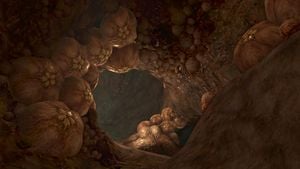
| |
| General overview | |
|
Distinctions: |
Large, spherical pods that contain Flood infection forms and incubate spores[1] |
|
Height: |
Varies[1] |
|
Mass: |
Varies[1] |
- "So many ways this sickness spreads itself! Keep your distance from those blisters, they seem to know when we are close!"
- — Pavium[2]
Flood blisters,[1][3] also referred to as Flood eggs[4] or Flood growth pods,[5] are a type of Flood infection form. They are large, bulbous sacs that contain other infection forms—typically pod infectors—and their membranes also function as incubation chambers for the development of spores.[1]
Overview[edit]
Physical characteristics[edit]
Blisters are created from non-sapient creatures or mangled corpses that have been deemed unfit for transformation into combat forms; after being seeded with Flood cells, the biomass rapidly transform into Flood blisters.[3] Their shapes and sizes vary, depending on what best fits the environment they are created in. However, most are pale sickly colored ovoid bulbs that distend from the Flood's existing membrane. Blisters in the incubation period may have a thin layer of skin, whereas matured blisters appear to have shed the skin, emitting a sickly yellow glow.[1]
Function[edit]
Flood blisters typically grow on walls and floors—adhered to surfaces using suction-cup-like appendages[6][7]—and particularly on surfaces covered with Flood biomatter;[8][9] as such, they are a common sight in the blightlands,[2] where they grow on surfaces as well as Flood stalks.[10] They have no means of defense, but if ruptured, they explode and release their infectious spores or their infection forms.[3] Blisters rupture after sustaining damage, but they may also burst voluntarily, especially when there are potential hosts nearby.[2][9] Given the Flood's highly infectious nature, blisters are considered one of the most pernicious aspects of the Flood, harboring the potential to transform an entire planet's biosphere if left unchecked.[1] Flood bomber forms are also known to release Flood blisters.[11]
In-game information[edit]
In Halo 3, blisters were encountered in the Campaign levels Floodgate and Cortana, and in the multiplayer maps Isolation and Cold Storage, though the blisters in multiplayer maps do not release infection forms. Hitting the blisters with flame-based weaponry will cause the blister to burst, but not release infection forms. It could be possible that the infection forms that are supposed to emerge burst along with the blisters, but it happens so quickly that it looks like one simultaneous explosion.
In Halo Wars, the Flood blisters are called Flood Eggs. Destroying these pods will sometimes reveal ![]() resources, but other times, they will release either a swarm of infection forms or a Flood spore cloud, both of which can infect infantry squads in seconds.
resources, but other times, they will release either a swarm of infection forms or a Flood spore cloud, both of which can infect infantry squads in seconds.
In Halo Wars 2, Flood blisters can be encountered in the Awakening the Nightmare campaign. They will detonate if any units get near them, releasing their payload of pod infectors or seeder infectors , but can also be destroyed from afar with weapons fire.
Production notes[edit]
- Flood architecture that release Flood enemies upon its destruction was conceived of as early as Halo 2. In an early design document for the level Quarantine Zone, there were references to a wall with "Flood crust" that contain Flood Juggernauts, which would burst out of the crust or burst out from its debris if players destroy the crust. In the final release, these Flood crusts were replaced with either bottomless pits or a dead end; one would have blocked access to a tunnel that leads to the next area, forcing players to destroy the crust and release a Flood Juggernaut.[12]
- In Halo 3, the Flood blister was modeled by Bungie artist Vic DeLeon. Subsequently, it was nicknamed "Vic's boo-bag" by Chris Barrett and Paul Russel.[7]
- Flood blisters were first named in the Phoenix Logs of Halo Wars 2: Awakening the Nightmare. Prior to this, their only known name had come from Vic DeLeon's presentation on Flood environmental design in Halo 3, where they were referred to as "Growth Pods".[5]
Gallery[edit]
Development images[edit]
Concept art of the Flood growth pods by Isaac Hannaford for Halo 3.
Flood blisters in the prototype High Charity level in Halo 3.
Flood sacks in Halo 2 Anniversary.
Concept art of the Flood blister for Halo Wars 2.
Screenshots[edit]
Blisters within the crashed Indulgence of Conviction in Halo 3.
A Flood bomber form dropping an egg in Halo Wars.
Flood blisters among the many Flood-themed Forge objects in Halo Infinite.
List of appearances[edit]
- Halo 2 (First appearance)
- Halo 3
- Halo Wars
- Halo Legends
- Halo Wars 2
- Halo Infinite
Sources[edit]
- ^ a b c d e f g Halo Encyclopedia (2022 edition), page 407
- ^ a b c Halo Wars 2, campaign level Light the Fuse
- ^ a b c Halo Wars 2, Phoenix Logs: Flood blister
- ^ Halo Wars, in-game unit
- ^ a b Bungie.net, Inside Bungie - Publications: Halo 3 Flood Alien Level Autopsy (Retrieved on Feb 3, 2009) [archive]
- ^ Halo 3, campaign level Cold Storage
- ^ a b Twitter, Vic DeLeon (@vicdeleon): "And he’s my Mudbox sculpt of the spore sac, affectionately known as “Vic’s boo-bag” by @cgbarrett and @docabominable" (Retrieved on Sep 26, 2022) [archive]
- ^ Halo 3, campaign level Floodgate
- ^ a b Halo 3, campaign level Cortana
- ^ Halo Wars, campaign level The Flood
- ^ Halo Encyclopedia (2022 edition), page 409
- ^ The Art of Halo, page 142
| |||||||||||||||||||||||||||||||||
